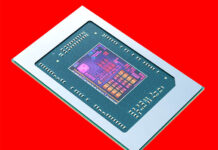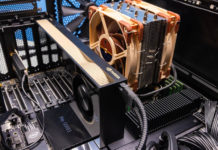We have been running a series looking at the new Jasper Lake Atom parts mostly for networking and virtualization. Perhaps the biggest challenge is the fact that many of those systems come from China and are from vendors with long lead times and questionable post-sales support. Enter the Gigabyte N5105I H which is a more standard motherboard from a well-known vendor that has the Intel Celeron N5105 “Jasper Lake” CPU onboard.
Gigabyte N5105I H Intel Celeron N5105 Jasper Lake Motherboard Launched
The motherboard itself is a mITX form factor. That, plus the relatively low-power 10W TDP CPU means that it can work in a variety of cases. Here is Gigabyte’s diagram with all of the features:

This is much larger than the 4x 2.5GbE router/ firewall boxes that we have looked at. It also has a lot more I/O with three display outputs (VGA, DisplayPort, and HDMI) along with more USB, including USB 3.2 Gen2, and audio. These features are certainly more desktop-focused than what we saw in some of the low-cost units via AliExpress. It also shows us just how small of a passive heatsink is required to cool this 105C Tcase CPU.
Although this is not the best in terms of networking compared to some of the other units we have looked at (for example Two Fanless Intel Celeron N5105 4x 2.5GbE Options Reviewed), there is another benefit. Gigabyte has its own qualification and BIOS stack that helps. That means TPM works and this can run Windows 11. There are even different hardware features like the PCIe Gen3 x1 slot that our readers may make use of.
Final Words
The Intel Celeron N5105 is getting close to the Core i5’s of the Skylake generation like the Core i5-6500T. Performance is going to be closer to the Core i3’s from that generation. Still, if you just wanted a low-cost desktop that does not use much power, perhaps this Gigabyte N5105I H is an option.





Cool I guess? Not to my taste. Lack of 2.5gbe, lack of an x16 pcie, use of so-dimm, and only one sata. A change to any one of those would pique my interest. Otherwise this had better be dirt cheap due to the lack of any one upgraded feature.
Also, not interested in dongles to accomplish upgrades.
Use the M.2 with a SATA adapter, convert the PCIE with an NIC, and we got a low cost DIY NAS!
If this would have a 8X pcie (or 16X) and better networking, then it would be so much usable. Such a shame!
One SATA port is all anyone will ever need!
What an inefficient use of PCIe lanes lol
There’s nothing different between this Atom ITX board and prior gen Atom ITX boards. None of the mainstream boards have beyond a single x1 slot. This board’s M.2 M key slot is x2 so it’s not suitable for most NICs. With only 8 lanes, and the lanes not even being able to be fused to a single x8 lane, there are real constraint decisions to be made in a design. Each additional controller (even something like using an Intel ethernet MAC, wireless CVNi) consumes at least 1 lane. Jasper/Elkhart Lake lane configuration has never been released, but on Gemini Lake with 6 lanes the lane fusing was limited to: 1×4 + 1×2, 4×1, 2×1 + 2×2. These platforms are meant for POS systems or low power office PCs.
@Jay; I’d absolutely agree that this thing doesn’t seem to be aimed at network appliance type applications(the CPU only has 8 PCIe lanes to work with; but they could have brought out a few more to provide at least a 4x expansion slot if so); but that fact makes me a bit curious about who it is for:
Especially at this price point, the overhead of the fully ATX power inputs/implied need for a PSU, etc. seem like they’ll make this a non-starter versus competing minimum-viable-mini-PC products that skip all that and just have a single DC input, no PCIe x1 slot, just one storage m.2 and one wireless option m.2; so it doesn’t seem to be aimed at integrators/PC OEMs; but without either at least an x4 expansion slot or a couple of x1s, it doesn’t seem like it’s aimed at the low-volume/DIY appliance use case; which just seems to leave it between purposes.
I wouldn’t say no to one if somebody gave it to me; but given that the expansion capability is too low to fit most custom cases; and the full normal-ATX-PC style makes it more expensive than task specific competitors, it seems like it’s neither one nor the other.
ASRock made a couple of boards similar to this only for low power pc or Htpc
I like mITX , if something like this i7 with 2×32 SODIMM exist I don’t mind paying extra money. Gigabytes can even sell the heat sink that will work with the i7.